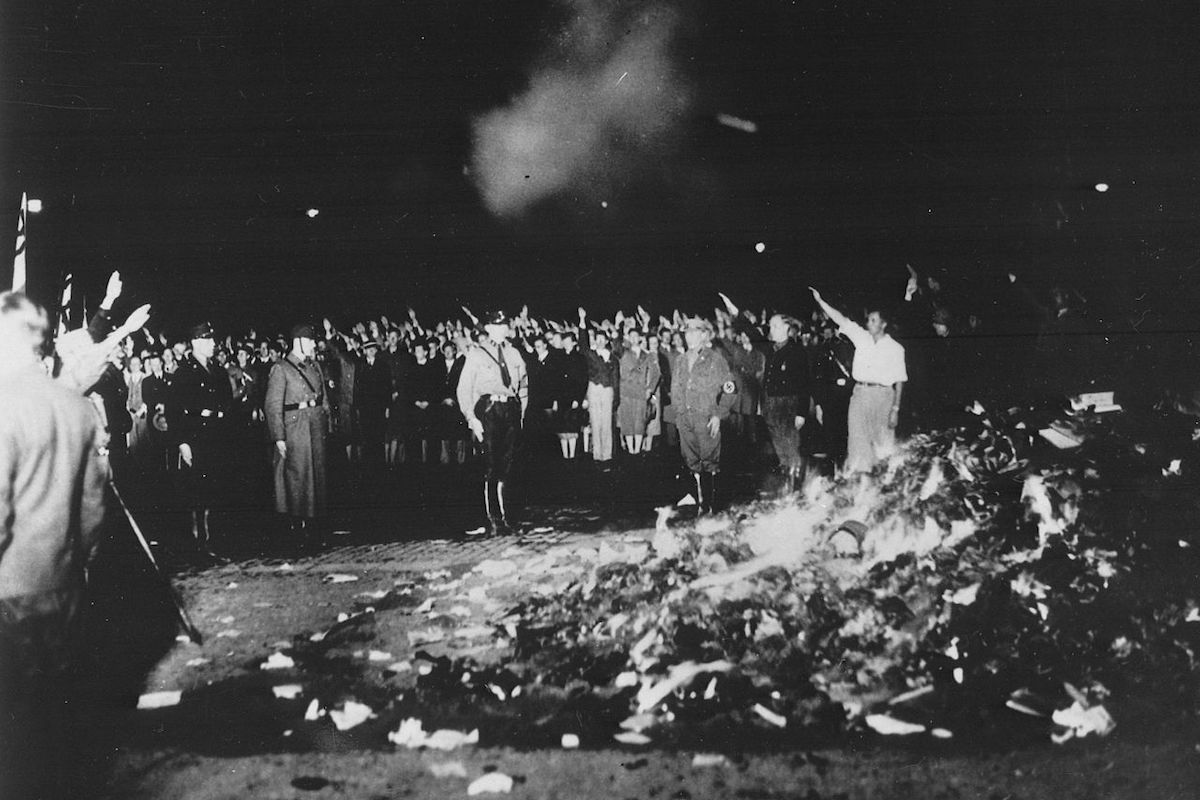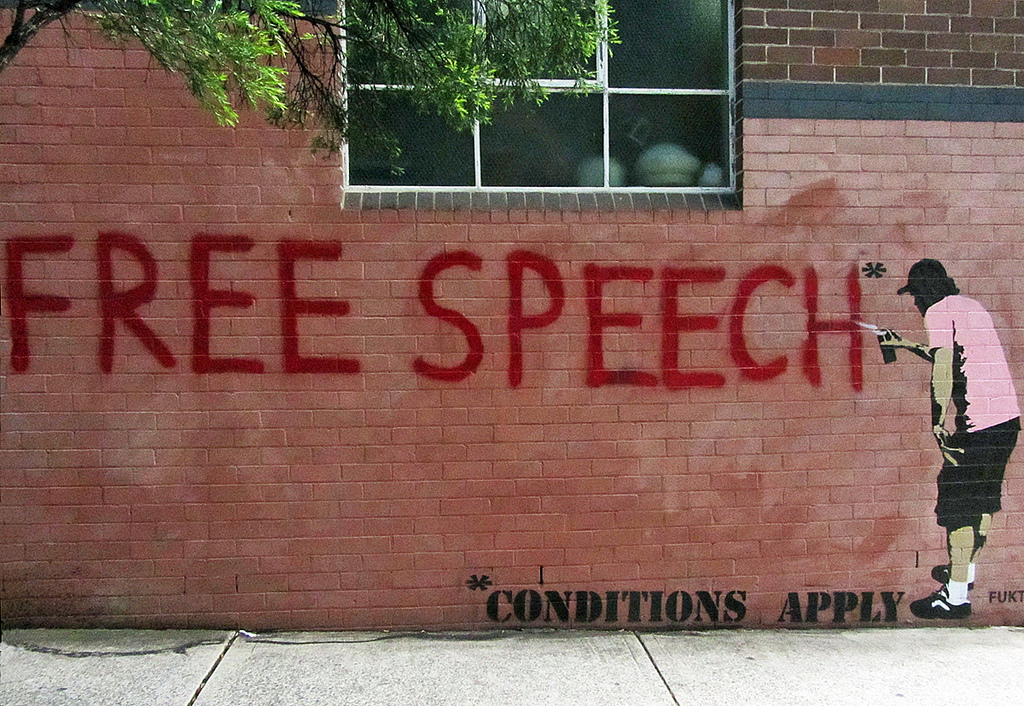Free Speech
Book Burning at Midnight, May 10th, 1933
Following the Nazis’ defeat by the Allies, the imagery lived on. In succeeding decades, projections of the book burning were never long out of sight or reference.

At the stroke of midnight on May 10th, 1933, the National Socialist German Students Union ignited a bonfire that—in the American imagination, at least—would never entirely flicker out. Illuminated by floodlights and flames, broadcast live on German radio, filmed by the newsreels, and rewound in archival documentaries ever after, the book burning by the Nazis, a festive confab held at 62 institutions of higher learning throughout Germany, was a picture-perfect metaphor for totalitarian thought control.
The origin story for the grandest of the Nazi bonfires is instructive. Staged for the media with all the premeditation of a Nuremberg rally, it was held at the Opera Square in Berlin, between the Opera House and the University of Berlin, two sites formerly dedicated to art and education. In another sign of the times, the event was very much a student-sponsored extracurricular activity. After meeting with like-minded professors and coordinating with Nazi party officials, the students fanned out across Berlin ransacking libraries, book stores, and private collections. On the big night, a raucous procession of 5,000 torch-bearing undergraduates, boys and girls alike, marched through the streets, singing Nazi anthems and carrying banners. “How the Filth Industry Worked under Scientific Disguise,” read one sign, a reference to the Institute of Sexual Science in Berlin, presided over by the famed sex psychologist Dr. Magnus Hirschfeld, whose costly library was requisitioned for fuel.1 A bust of Hirschfeld was held aloft on a pole (he was fortunate that it was just his bust).
At the Opera Square, a crowd of 40,000 stood in the drizzling rain waiting for the first match to be struck. Around a granite block, protected by a thick covering of sand, a wooden pyre had been erected, made from crossed logs, 12 feet square and five feet high, soaked in gasoline. Of the four ancient elements, fire was always the Nazi favorite. Included in the kindling were works by Karl Marx, Sigmund Freud, Albert Einstein, Erich Maria Remarque, Stefan Zweig, and both Mann brothers, Thomas and Heinrich. American literature was represented by Jack London, Ernest Hemingway, Upton Sinclair, and Helen Keller (Keller earned her place on the pyre twice over—as a socialist and a living rebuke to Nazi eugenics).
Once the fire was lit, students stepped up to a small, swastika-draped rostrum where microphones had been set up. Before testing their throwing arm, each recited a brief “flame speech” with a fill-in-the-blank offering. “I hereby consign to the flames—” they declared, and inserted the name of the author and the indictment:
“Emil Ludwig—burned for literary rascality and high treason against Germany!”
“Sigmund Freud—for falsifying our history and degrading its great figures!”
“Eric Maria Remarque—for degrading the German language and highest patriotic ideal!”
And so on. “German education has been purged of smut and dishonesty,” declared student leader Herbert Gutjahr, well-satisfied at the estimated 20,000 volumes being turned to cinders.2
After the incantations by the students, a guest speaker took to the rostrum to deliver the centerpiece flame speech. Dr. Paul Joseph Goebbels—PhD in Romantic Literature, failed novelist, and Reichsminister for Popular Enlightenment and Propaganda—was delighted to officiate at the incineration of the print-based strain of what he called entartete kunst (“degenerate art”). “The epoch of morbid Jewish intellectualism is terminated!” he bellowed. “The old goes up in flames and the new shall be fashioned from the flames in our hearts.”3 In his diary the next day, Goebbels gave his performance a rave review. “In the late evening speech in the Opera Square, in front of the pyre of the filthy and trashy books burned by students, I am in great form,” he enthused.
Though the book burnings were held in university towns throughout Germany, the bonfire on the Opera Square was the blow-out preserved for the ages. Both German and American newsreel crews were there early, setting up equipment and angling for the best view. All newsreel footage that left Germany was strictly censored, so the Nazis wanted the outside world to see the film. The preparation paid off. The cameras captured mesmerizing night shots of students and brownshirts, silhouetted by the blaze, tossing armfuls of books into the flames, their pages flapping in the air before being consumed by the fire. The glow created an eerie chiaroscuro effect, a tableau that might have been lifted from the lighting schemes of German Expressionist cinema.
The footage reached American newsreel houses in New York on the weekend of May 26th–28th, 1933, and filtered down to neighborhood theaters nationwide thereafter. Hearst Metrotone News played the firestorm for laughs, as if they represented nothing more serious than an outburst of schoolboy shenanigans. “It’s a big night for the younger Hitler set!” the buoyant narrator chirped. “The college boys are making Berlin safe for Nazis by burning up books that might lead Germans astray!” Yet Hearst’s flippant tone was an outlier. By most accounts, audiences watched the scene in grim silence or spat disgust.4 Walking into the recently opened Radio City Music Hall, Art Arthur, entertainment reporter for the Brooklyn Daily Eagle, was pleased to hear the entire audience—the venue sat 5,000—“joining in hissing the newsreel views of the Nazis burning banned books.”5

American commentators reacted to the news pretty much the way the audience at Radio City did. “In one leap, German culture has bounded back to the Twelfth Century,” remarked the Philadelphia Inquirer.6 NBC radio correspondent Max Jordan condemned the torching of “the very intellectual foundations of a once proud nation” by “the deadly attack of a yelling mob.” Columnist Walter Lippmann was appalled, but confident that the invention of the printing press prevented any government, no matter how savage, from extinguishing “the intellectual heritage of mankind.” He hoped the bonfires would be quenched by “the cool waters from the springs of human decency,” but feared, prophetically, that only “the blood and the tears of men” would ultimately douse the flames.7 Time, never a magazine to resist the chance to coin a neologism, called the incineration a “Bibliocaust.”
Constant reviewing soon imprinted the newsreel footage of the book burning onto the American imagination. Two pioneering anti-Nazi films, the documentary Hitler’s Reign of Terror (1934) and the docudrama I Was a Captive of Nazi Germany (1936), each unspooled extended footage from the bonfire newsreels. “No such acts of barbaric vandalism have been recorded in modern history,” intoned narrator Edwin C. Hill in the former. “The destruction was aimed primarily at the Jews who had furnished some of the greatest names in the world’s literature.” The bonfire was also re-staged in Hollywood feature films—allegorically in The Life of Emile Zola (1937), when a French mob tosses copies of Zola’s J’Accuse! into a bonfire; and literally in The Mortal Storm (1940), when a gemütlich college town succumbs to the Nazi fire fever.
By WWII, newsreel scenes of the Nazi book burnings were serving as an all-purpose signifier of all that was anti-intellectual and barbaric about Nazism. In Prelude to War (1942), the first episode of Frank Capra’s seven-part Why We Fight series, the by-then familiar footage was jazzed up with close-ups of the book covers superimposed over and sucked into the flames of the pyre. “Over here, John Q. still read what he pleased,” narrator Walter Huston reminds his wartime audience.
Following the Nazis’ defeat by the Allies, the imagery lived on. In succeeding decades, projections of the book burning were never long out of sight or reference. The prime time telecast of The Rise and Fall of the Third Reich (1968), the documentary adaptation of William L. Shirer’s classic history, taught the lesson to a new generation: “In Nazi doctrine it is not enough to eliminate those impure in body and mind—ideas must also be destroyed,” says the narrator when the inevitable imagery unspools. Steven Spielberg staged a Nazi book burning in Indiana Jones and the Last Crusade (1986), during which Indy scores an autograph from Hitler. In 2007, the US Holocaust Memorial Museum organized a traveling exhibition, “Fighting the Fires of Hate: America and the Nazi Book Burnings.” And, of course, thanks to Ray Bradbury’s meditation on the trope, we know the precise temperature at which paper catches fire and burns.
Like the torchlit parades, the Teutonic funeral processions, and the other Nazi pageants that make up the highlight reel of what Susan Sontag called “fascinating fascism,” the book burnings were not mere pseudo-events—something that would not have happened had the cameras not been there—but ritual enactments of the totalitarian mindset. The German word was Gleichschaltung, the inculcation of the Nazi ethos into every aspect of German life—language, lineage, behavior, and, of course, reading material. The stagecraft on the Opera Square was a policy statement in low key lighting, and a menacing harbinger of the conflagrations to come.
References:
1 “Hirschfeld, Famous Sex Psychologist, Dies,” Syracuse Journal May 16th, 1935: 1.
2 “Quotations,” Brownsville Herald, May 31st, 1933: 4.
3 “Book Bonfires Blaze in Reich,” Los Angeles Times, May 11th, 1933: 3; Charles L. Flick, “Nazi Pyres Consume Anti German Books,” San Francisco Examiner, May 11th, 1933: 6.
4 Tom Waller, “Newsreels,” Variety, May 30th, 1933: 14.
5 Art Arthur, “Reverting to Type,” Brooklyn Daily Eagle, May 29th, 1933: 9.
6 “Editorial Comment,” Philadelphia Inquirer, May 17th, 1933: 10.
7 Walter Lippmann, “Today and Tomorrow: The Burning of the Books,” Cincinnati Enquirer, May 12th, 1933: 4m,”






